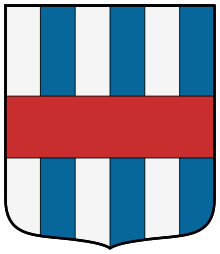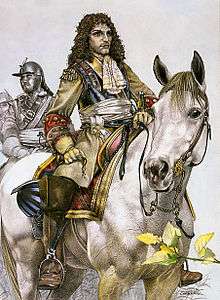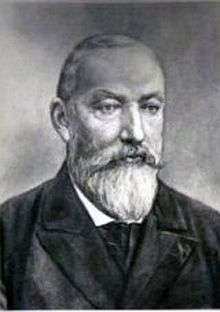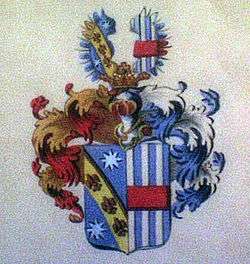Gundulić family
| Gundulić Gondola | |
|---|---|
 | |
| Country |
Republic of Ragusa Austria-Hungary |
| Founded | 930 |
| Titles | Count |
| Dissolution | 1800 |
| Cadet branches | House of Getaldić-Gundulić |
The Gundulić (known in Italian as Gondola[a]) was a noble family of the Republic of Ragusa, considered one of the most prestigious families of the republic. It had origins in southern Dalmatia and Tyrol. The family´s motto is Tout ou rien ("All or nothing").
Origin
According to historian Serafin Cerva, the Gundulić patriciate dates to 930, as does those of Gozze, Pozza and Giorgi, meaning that they were deemed the oldest ones of Ragusa.[1] The first known member of the Gundulić family was known as Silvanus. The mention of the name comes from 1024. The name Gundulić derives from Greek, xovbu (vase à boire), as said, or xouvrexac; (barque).
Middle Ages
In the 13th century, three generations of this family took leading roles in the public life in Ragusa. In the 15th century, Paladino Gundulić held the important position of a diplomat of the Republic to the Kingdom of Naples and Skanderbeg.[2]
17th century
The poet Ivan Gundulić (1589-1638) became the most significant person in the Gundulić family, being named the Count of Konavle in 1615 and 1619. In 1634 he became a senator. At the end of 1638 he was elected to the Small Council, but died before taking office. Ivan married Nikoleta Sorkočević, daughter of Šišmundo Sorkočević.
Ivan's son, Frano, served the Austrian Empire and the Polish King Jan III Sobieski in 1683, participating in the defeat of the Ottoman Turks at the Battle of Vienna. The family then obtained fiefdoms from Emperor Leopold I. The others sons, Šišmundo (Šiško) and Matej, spent several years in the military service of the Spanish Habsburgs. After his return to Dubrovnik, Matej lived in Turkey for 28 months, until 1674. Matej later married a commoner, but had no children. He was elected the Rector of Ragusa many times.
On 20 April 1693 the Secretary of the Republic of Ragusa, Michael Allegrettus, confirmed the nobility of the family on behalf of the Rectors and the Great Council (Consilium Maius), it's patrician status.
See also
- Benedetto Gondola (fl. 1316), merchant in Ancona
- Paladino Gondola (fl. 1423–72), diplomat and merchant
- Trojan Gundulić
- Ivan Gundulić
- Fran Dživo Gundulić
- Šišmundo Gundulić
- Dživo Šiškov Gundulić
- Frano Getaldić-Gundulić
- Šišmundo Getaldić-Gundulić
Annotations
- ^ Usage of the name "Gondola" in English-language sources.
Selected examples:- David Rheubottom (2000), pages 4, 21, 33, 62
- John Thomas (2009), page 1055
- Dubrovnik Annals (2007), pages 42 and 63
- Virginia Cox (2011), pp. 216, 238 and 261
Usage of the name "Gundulić" in English-language sources.
Selected examples:- Harris (2006), p.296
- Goy (2001), p.28
- Rossiter (1969), p.159
- Hochman (1984), p.434
- Sugar (1993), p.181
- Cvitanic (2011), p.112
References
- ↑ Viscountess Emily Anne Beaufort Smythe Strangford (1864). The Eastern Shores of the Adriatic in 1863: With a Visit to Montenegro. R. Bentley. pp. 129–.
- ↑ Bojović (1998), p. 197
Gallery
 Ivan Đivo Gundulić (1622)
Ivan Đivo Gundulić (1622) Fran Đivo Gondola (1683)
Fran Đivo Gondola (1683) Frano Josip Gondola biskup od Tempe (1766)
Frano Josip Gondola biskup od Tempe (1766) Frano Agostino Ghetaldi-Gondola
Frano Agostino Ghetaldi-Gondola Baron Frano Gundulić
Baron Frano Gundulić Getadić-Gundulić Memorial Lapad Cemetery
Getadić-Gundulić Memorial Lapad Cemetery Coat-of-arms of the House of Getaldić-Gundulić
Coat-of-arms of the House of Getaldić-Gundulić
Sources
- Harris, Robin (2006). Dubrovnik: A History. Saqi Books. ISBN 0863569595.
- Goy, Edward Dennis (2001). Love and death in the poetry of Šiško Menčetić and Džore Držić. Akademija Nova. ISBN 8670620081.
- Rossiter, Stuart (1969). Yugoslavia: the Adriatic Coast. Benn.
- Hochman, Stanley (1984). McGraw-Hill Encyclopedia of World Drama. VNR AG. ISBN 0070791694.
- Sugar, Peter F. (1993). Southeastern Europe Under Ottoman Rule, 1354-1804. University of Washington Press. ISBN 0295960337.
- Bojović, Boško I. (1998). Création musicale et nationalismes dans le Sud-Est européen (in French). Association Pierre Belon. ISBN 978-2-910860-06-6. Retrieved 22 August 2011.
- Cvitanic, Marilyn (2011). Culture and Customs of Croatia. ABC-CLIO. ISBN 0313351171.
- Rheubottom, David (2000). Age, Marriage and Politics in 14th century Ragusa. Oxford Studies in Social and Cultural Anthropology. ISBN 0198234120.
- Thomas, John (2009). The Universal Dictionary of Biography and Mythology. Cosimo Classics. ISBN 9781616400712.
- Various authors (2007). Dubrovnik Annals Volumes 10 and 11. Croatian Academy of Sciences and Arts.
- Cox, Virginia (2011). The Prodigious Muse: Women's Writing in Counter-Reformation Italy. The Johns Hopkins University Press. ISBN 9781421400327.

